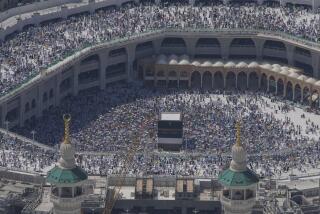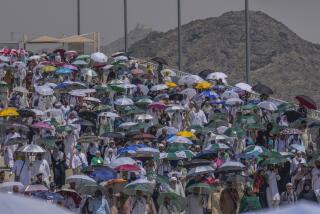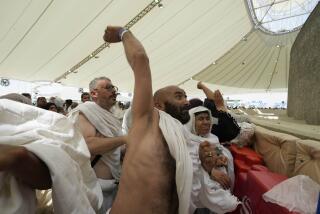Spiritual Journey : Islam: 91 Muslims from Los Angeles return from pilgrimage that is religious experience of a lifetime.
Ehsan Khanâs prayers were finally answered this year.
He, along with 90 other Muslims from Los Angeles and 3 million Muslims from across the world, recently visited Saudi Arabia to complete the Hajj--the pilgrimage to the holy cities of Mecca and Medina.
âItâs not like a vacation,â said Khan, a Reseda resident who grew up in Canada but whose parents are Pakistani. âIâve been asking God for years to be able to go, and this time I was accepted.â
Every physically and financially able Muslim is required to complete the Hajj during his or her life. A pilgrim must be an adult to go on the Hajj.
Many people in countries distant from Arabia look upon the completion of the Hajj as the climax of a lifetime. But Khan, who is 32, is one of a growing number of people embarking on the pilgrimage earlier in life.
Hassan Khan, 29, who also recently returned from Mecca, said he is encouraging people to go on the Hajj when they are young.
âTo get to the height of spirituality, why wait until you are old to mend or correct your ways?â asked Hassan Khan (no relation to Ehsan Khan), a Sun Valley salesman who came to the United States from Pakistan when he was 18. âYou might as well shape up your behavior at an earlier age.â
The pilgrimage begins on the eighth day of Zul-Hijjah, the last month of the Islamic year, and ends on the 12th day. The Islamic year runs on a lunar calendar, which is about 10 days shorter than the solar calendar. This year the Hajj started on June 9.
The Saudi government usually allows only 2 million people to visit Mecca during the Hajj, and each country has its own pilgrim quota. Visits to Mecca declined last year because of the Gulf War, so the Saudi government increased the quota to 3 million this year.
Visiting the Kaaba, a cube-shaped brick structure about 40 feet tall, is one of the most important rituals of a pilgrimâs stay in Mecca. The Kaaba is considered the House of Allah, and signifies the oneness of God. Every Muslim in the world must pray in the direction of the Kaaba.
âThere is no other particular place in the world where you can see people of every color, dress, language and culture, going and doing the same thing,â said Ehsan Khan, a certified public accountant. âItâs beautiful, and spiritually uplifting. There is nothing like it.â
In the old days, people visited the holy city on foot, by camel or by whatever means they had available. Todayâs pilgrims come by air and sea, and once they arrive, they travel by bus.
In the United States, travel agencies offer Hajj packages. From Los Angeles, the cost of a month in Saudi Arabia, including travel and lodging, is about $3,500 per person. The Saudi Hajj department also assigns each group a guide, and that cost is included in the package.
The pilgrimage is extremely taxing. Visitors are confronted by tremendous heat and crowding, as millions attempt to complete the necessary rituals. The Saudi government provides tents and water, as well as medical facilities, to make the process easier and safer. But historically, it has not been uncommon for older people to die during the Hajj. It is considered a blessing to die and be buried in Mecca.
Despite the heat and crowding, those who made the pilgrimage from the United States say the hardships they endured were worth it.
âBefore I went, I didnât know what to expect,â said Artis Terrell, 41, a South Gate chiropractor who converted to Islam in 1973. âBut once I was there, in Mecca, at the Kaaba, the place where we prostrate ourselves five times a day, itâs an overwhelming feeling. Going there is like a personal invitation God extends to the believer.â
Muslims pray five times a day facing Mecca. Those prayers represent the second of the five pillars of Islam. The Hajj represents the fifth.
Before the pilgrims enter Mecca, the men must put on the ihram garments, two white seamless sheets wrapped around the body to symbolize the equality of every man in the eyes of God. Women retain their usual Muslim dress, and are completely covered except for their faces and hands.
Jane Farra, a Shadow Hills resident who converted to Islam 11 years ago, is accustomed to Western-style dress. But she said she had no problem dressing as a Muslim woman while completing the Hajj.
âIt felt fine, it felt perfect,â said Farra, 53, whose husband of 32 years is Muslim. âYou are doing a religious act, and this is the way you are told to dress at the time. It was no problem.
âWhen you are there, you donât think of men and women, you are just a Muslim among all those millions of Muslim people,â she said. âFor myself, it was the most wonderful thing. I felt close to my religion and in the presence of God.â
Once the pilgrims enter Mecca, they walk seven times around the Kaaba inside the Great Mosque, and kiss or gesture a kiss to the Black Stone, the oldest part of the Kaaba. The Muslims believe that the Black Stone came from the heavens in the time of Abraham.
Next they pray in the direction of the Kaaba, drink the holy water from the well of Zam Zam, and walk briskly seven times between the small hills of Mt. Safa and Mt. Marwah. Each action symbolizes the search for water by Hagar, the wife of Abraham, according to the Koran.
At the second stage of the ritual, the pilgrims visit the holy places outside Mecca, including Arafat and Mina. The Hajj is considered incomplete if the pilgrim is not in Arafat on the ninth day. In Muslim tradition, Arafat is the place where Adam and Eve first met.
At Mina, the pilgrim throws seven stones on three successive days at three pillars representing Satan. Later, an animal is sacrificed in commemoration of Abrahamâs potential sacrifice of his son Ishmael. Afterward, the male pilgrim cuts his hair or shaves his head.
Before he leaves Mecca, he again circles the Kaaba seven times. Either before or after the Hajj, pilgrims usually visit the Prophetâs Mosque in Medina, where Mohammed, the founder of Islam, is buried. Only Muslims are allowed inside Mecca and Medina.
âAs a Muslim, once you go and see the Kaaba for the first time, the feeling is not explainable,â Ehsan Khan said. âThatâs the meaning of life right there, the closest you can get to God. You feel swept away, there are no words to describe it.â
More to Read
Sign up for The Wild
Weâll help you find the best places to hike, bike and run, as well as the perfect silent spots for meditation and yoga.
You may occasionally receive promotional content from the Los Angeles Times.






